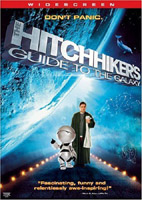 BUY IT AT AMAZON: CLICK HERE!
BUY IT AT AMAZON: CLICK HERE!
STUDIO: Disney
MSRP: $29.99
RATED: PG
RUNNING TIME: 109 min.
SPECIAL FEATURES:
• Commentary tracks
• Making of featurette
• Deleted scenes
I haven’t read Douglas Adams’ novel The Hitchhiker’s Guide to the Galaxy (or its follow-ups) since high school, which I’m sad and mildly horrified to say was nearly half my lifetime ago, so I don’t have the same level of emotional investment in the spacetrotting adventures of unlucky gent Arthur Dent as the anxious Adams enthusiasts who’ve waited years for a faithful adaptation of the material. And yet even without that attachment, I was ultimately not all that impressed with the result.
The Flick
Shortly after all the dolphins leave our world (to a maddeningly memorable musical number), we meet our hapless hero Arthur Dent (Martin Freeman of the original BBC series The Office), who’s battling bureaucracy and the impending demolition of his

Even swapping religions wasn’t enough for Madonna to prevent the rigors of age.
Fortunately for Arthur, his buddy Ford is actually an alien – specifically one who knows how to hitch a ride on nearby starships, which then leads them from suffering through Vogon poetry to escaping in a passing space orb called the Heart of Gold, where Arthur reunites with fellow human Trillian (Zooey Deschanel). Both the ship and the girl are objects essentially stolen by the zealous Zaphod Beeblebrox (Sam Rockwell), the galaxy’s randy rogue president. Increasingly improbable events lead to Trillian’s capture by the Vogons, and the men, along with misery machine Marvin (little guy Warwick Davis/vocal-thrower Alan Rickman), must come to her rescue, an adventure that involves a landscape of face-slapping apparatus, a cult that worships a giant nose, and a guy who builds planets.
Based on the early glimpses and clips, I fully expected Hitchhiker’s Guide to be one of my favorite movies of 2005, but instead it’s like opening a new bottle of delicious crème soda only to discover it’s flat. While inconsistently engaging, most of the film just feels oddly humdrum, with humor and characters that never quite congeal. Freeman has the sardonic cluelessness required for the part of Dent, and despite his controversial casting, Mos Def works well enough as Ford (count your blessings he didn’t go all Don Cheadle with the Cockney). But at no point do they seem like best friends of many years — aside from their slightly homoerotic initial meeting, there’s nothing to indicate any familiarity beyond casual acquaintances. What’s worse, the nature of their roles relegates them both to standing around and simply reacting to events for much of the running time, so rather than acting as conduits for vicarious heroics, they’re just like us — simple spectators among the insanity.
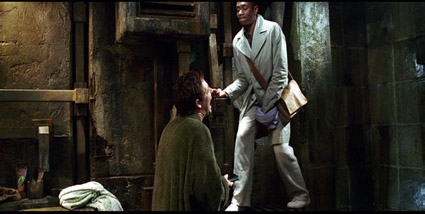
Hmmm… in retrospect, maybe they’re closer friends than I initially thought.
And then there’s Arthur unconvincing love triangle with Trillian and Zaphod (who we learn actually abducted her from Arthur’s advances an Earth party). As adorable as she is, saucer-eyed Deschanel (who delivers her dialogue as though she’s rolling it around in her mouth before releasing it) has a subdued capriciousness that never comes across as especially obsession-worthy, and her eventually mutual affection with Arthur merely feels scripted. Romance aside, this is Rockwell’s show anyway, and he injects an incessantly manic verve into the bombastic being of Zaphod, the untethered yin to Arthur’s acerbic yang, which unfortunately just shoves our “hero” further into the background he already inhabited.
Director Garth
Anyone familiar with
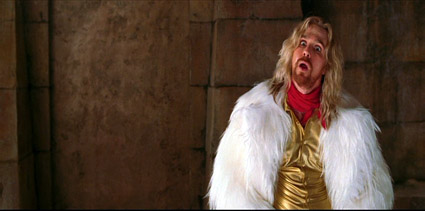
I’d like to say Sam has come a long way since Galaxy Quest, but…
Not content with the challenge of bringing Adams’ existing abstract ideas to life, the filmmakers (including screenwriters Karey Kirkpatrick and Adams, posthumously) have decided to toss in even more random concepts like the “Point of View Gun”, a weapon that Zaphod’s apparent nemesis Humma Kavula (a gleefully diabolical John Malkovich) sends him to retrieve, evidently to give Zaphod something to do in the third act. When they find the gun and test its effects, Trillian remarks “I can see why he’d want that.” I just wish the rest of us knew, too — she may as well have just said “We’ll need this for the climax”. Rather than anything resembling a comprehensible narrative, the story just propels the characters through a dizzying itinerary of tangents until we can’t even remember what they were supposed to be doing in the first place, a sensation that lasts right to the absurd and unsatisfying ending. It feels as though a lot of material landed on the cutting room floor, but if it did, it wasn’t rescued for inclusion on the DVD.
Despite the talented cast, occasional inspired moments and all that visual zow, Hitchhiker’s Guide is a failed bonfire: there’s a lot of huffing on the tinder, and it produces a few sparks and even some minor flames, but it never erupts into the anticipated inferno.
6.0 out of 10
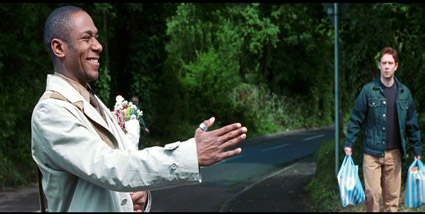
Mos is caught practicing for his convention meeting with idol Andrew Divoff.
The Look
Sporadic though it may be, the film has plenty of personality and the anamorphic widescreen (2.35:1) captures it admirably. But if any technical aspect of the disc gets the short end of the bitrate stick, it’s probably the transfer.
8.0 out of 10
The Noise
A vigorous DTS track is the aural delicacy on this disc, with loads of laser salvos and whooshing starships and rumbling space cruisers and planets imploding – all the stunning stuff that should sound stellar in a 21st century sci-fi production.
A serviceable Dolby 5.1 is also available for the DTS-less proletarians.
9.4 out of 10
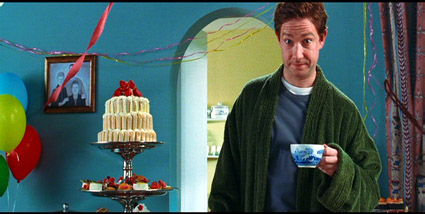
Worst Mr. T costume ever.
The Goodies
The DVD menus reproduce the rainbow-colored interface of the Hitchhiker’s Guide as it appears in the film, a neat touch. There’s also an Infinite Improbability Drive button, which “activates” the Heart of Gold’s engine and then shows a random selection from the alarmingly limited array of special features (expect a 2-disc edition in the future).
The first commentary features
Aside from that is a disappointingly brief “making of” featurette, that clocks in at 8 minutes and breezes through every aspect with a sense of velocity that the film itself could’ve used (I could have watched at least 30 minutes on the Vogons themselves, but admittedly I’m a nut for practical effects). There are also a handful of deleted bits, including an additional guide entry and two “fake” deleted scenes that, much like the film, aren’t as witty as they could or should have been. On top of that is an irksome Hangman game and a superfluous singalong of the dolphin song that opens the film. And, naturally, some trailers.
5.0 out of 10
The Artwork
It’s the theatrical poster, or almost, anyway. Arthur looks suitably confounded as Marvin points to all the
7.0 out of 10
Overall: 6.2 out of 10